
|

|
|
Home Site Search Contact Us Subscribe
|
|
The Pop-up Phenomenon, Made in America To meet a growing demand, Hofmann Architecture's Living Vehicle is an architectural platform offering mobile, easily deployable business and housing options. By Shirley Styles August 9, 2018 The pop-up, direct-to-consumer mobile business phenomenon has taken America by storm. Entrepreneurs, investors, political decision makers, and planners are scrambling to respond to the consumer’s positive response, and outright demand to surf the pop-up wave. “We are witnessing a major shift in the way we do business,” says 35-year-old architect Matthew Hofmann, co-founder of Santa Barbara, California-based Hofmann Architecture. To meet consumer demand, a handful of specialty architects have honed their focus on designing spaces that house a plethora of mobile, low-cost, easily deployable business and housing options.
Hofmann’s Living VehicleTM is one such architectural platform that is responding to a more nomadic style of business. “The full-time permanent building is just one of the components for retail, dining, and full-time housing we are serving,” says the Hofmann, who’s lived with his wife, Joanna in a renovated Airstream, a traditional RV, and a boat since 2009. “Mobile and semi-permanent hospitality, commercial, office, retail, and dining are just a few of the sectors we are beginning to service,” he Hofmann. “All founded on the simple fact that we can operate in this new way not in lieu of, but because of technology.”
In 2010, Hofmann designed and created the greatly successful AutoCamp, an Airstream hotel located near downtown Santa Barbara, California, with a relatively low-investment that continues to deliver a high-value hospitality experience. Within a couple years, Hofmann sold his share of the AutoCamp to his partner, who is expanding the hospitality concept through the U.S.
Birth of Direct-to-Consumer Business
In 1906, a Bostonian businessman birthed one of America’s most enduring and ingenious business models that continues to impact the way entrepreneurs connect with consumers more than a century later. A $375 investment was all that Alfred Fuller needed to start the Capital Brush Company. The ensuing years spawned an army of Fuller Brush men who took to America’s cities and rural communities to make direct door-to-door sales of commercial and household cleaning products.
Nearly 100 years later, there are pop-up restaurants, such as Spork in Central Oregon. In 2009, Spork was a street-food kitchen that served up delicacies to diners from the window of a 1962 Trade Wind Airstream. The formula was as successful as it was simple, with a relatively modest capital outlay and direct-to-diner experience that greatly reduced the owner’s risk. The results were dramatic and instantaneous. In 2013, Spork added a 50-seat brick-and-mortar service counter location in Bend, Oregon, that serves lunch, dinner, and cocktails.
Mobile diner reviews often exceed those of traditional restaurant fare thanks to lower site and building costs, which allows the chef to invest more in high-quality ingredients. The bottom line is a higher return on the owner’s investment.
Today, many of these direct-to-consumer eateries continue as mobile diners in renovated trailers and pop-up steel containers. Their presence often brings a renewed buzz of energy and commerce to neighborhoods that were otherwise under-utilized – typically in-filling vacant city lots, free street-side parking, or subleasing a parking space next to an existing brick-and-mortar establishment.
Land Use Issues Abound
Hofmann believes the pop-up design industry is responding properly to the way we do business. “It’s a fundamental adaptation to the digital age,” he says. “Brick-and-mortar stores are going out of business left and right, being replaced by their web-based counterparts – providing a lower cost product, better service, and overall easier user experience.” However, Hofmann points to one major item that is lacking: a broken personal connection that a business has with the consumer. “Whether it be marketing, tactile testing of product, or the employee-customer connection, it is a challenge that even the biggest businesses have yet to solve with the online model,” he adds.
In the hospitality sector, Hofmann’s Living Vehicle offers a mobile product that is able to effectively accommodate a customizable pop-up space, and offers many advantages:
● A small footprint and reduced impact on land ● Adaptable and modular for easy setup and removal ● Quick deployment and response to evolving land-use requirements ● Temporary in nature and self-contained so as not to disturb the underlying environment ● Higher return on investment for businesses with a lower cost per unit than a traditional building
There’s also a very important personalization factor in the pop-up phenomena, says Hofmann. “We’re in a transition to the digital retail age,” he says. “Many companies are facing the challenge of losing touch with their customer by adopting an online sales model. Pop-up marketing projects are allowing companies to interact with their customer face-to-face at a much lower cost, offering an easily adaptable business model. A mobile business can reach a broader diversity of customers at work, home, school, or play.”
Another advantage to pop-ups is that they are highly flexible and able to mediate a wide range of high barriers to entry markets, such as prime downtown urban centers. “The scalable platform offers a low cost of entry,” Hofmann says, “providing a much greater opportunity for small businesses to thrive – which is the backbone of American commerce and jobs.”
Less Stuff, More Connection
The Hofmanns are putting their Living Vehicle to the test with real world experiences in the retail, hospitality, and dining industries, as well as full-time mobile adventure seekers. “It’s the Wild, Wild West out there,” says Hofmann, who exudes the confidence of a buckskin explorer. “We’re blazing new trails with entrepreneurs and homeowners who have the courage to reach higher and wider. Our job is to help these trailblazers discover new ways to reach their adventurous dreams.”
There’s a palpable, less-is-more, back-to-basics priority among this merry band, too. “There’s no longer the premium placed on stuff,” adds Joanna Hofmann. “A 2002 New Yorker cartoon captured this sentiment with an elderly man lying on his deathbed saying, “I should have bought more crap.” Of course, no one says that in the end, but the question people are asking today is: What is my life saying about stuff today?
In less than a year, the Hofmanns, who are self-funding their operation, have sold nearly $3 million of product to mobile full-timers who utilize WiFi and satellite technology to work remotely. Some are transitioning into snowbirds who follow 75-degree weather around the U.S.
Living Vehicle is providing opportunities for greater adaptability for workers to move more efficiently to where the jobs are, and mobile businesses to follow their customers.
Hofmann’s buyers are a blend of full-timers who are finding loads of free land through the Federal BLM [Bureau of Land Management] and new mobile land-leasing concepts. In response to a housing crisis, the governor of California recently provided a statewide provision for auxiliary dwelling units (ADU) on residential property and vacant land.
The option of either off-grid or city hookups allows flexibility and adaptability with accommodations and locations. The four-season compatibility allows the Living Vehicle to function in extreme hot and cold climates.
The Hofmanns believe the American Dream is evolving. “It’s no longer the desire of many to own a large home with a hefty mortgage,” concludes Hofmann. “It doesn’t make sense to many people today to spend half their waking hours working at a job in a cubicle, being unhappy so they can be happy about taking a two-week vacation. The bottom line during this transition is about finding more economical and rewarding ways of working and living. It’s the American Way to focus on freedom while enabling individual choice to lead the life we each desire.”
Shirley Styles is a freelance writer who specializes in innovative design. She is a former small-town newspaper journalist and English teacher. Currently, she is a full-time outdoor enthusiast and lifelong RV fanatic who appreciates the mobile lifestyle.
Matthew and Joanna Hofmann, Living VehicleTM Founders The Hofmann family mantra, “experience is the best teacher,” tells the story of a young architect and his wife who came together out of a mutual passion for living well and living free. Inspired by years of traveling full-time in mobile spaces while running a custom mobile design firm in Santa Barbara, California, Matthew and Joanna saw the need for a new kind of mobile space designed to support a range of modern mobile businesses and lifestyles. As a long term goal, the company is driven to create a sustainable solution to the global housing crisis by developing a completely self-supporting, net-zero product.
|
(click on pictures to enlarge)  Courtesy Living Vehicle Nature’s Promise Airstream, designed by Hofmann, set up in Boston 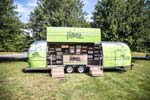 Courtesy Living Vehicle Nature’s Promise Airstream - road trip! 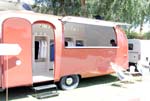 Courtesy Living Vehicle Kit and Ace traveling pop-up boutique The Copper Studio, designed by Hofmann 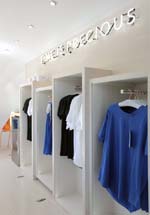 Courtesy Living Vehicle Kit and Ace pop-up boutique interior 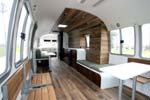 Courtesy Living Vehicle Hofmann designed this Airstream for a book tour for Tony Hsieh's "Delivering Happiness: A Path to Profits, Passion, and Purpose" 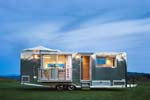 Courtesy Living Vehicle The Hofmann's own home on wheels 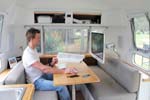 Courtesy Living Vehicle Matthew Hofmann at work in lounge-turned-home-office 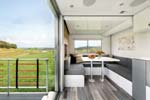 Courtesy Living Vehicle U-Lounge set in dining position 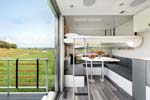 Courtesy Living Vehicle A Euroloft bed automatically lowers from the ceiling 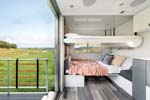 Courtesy Living Vehicle With the dinette easily transformed into a bed, the LV can sleep up to six 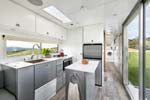 Courtesy Living Vehicle Chef’s kitchen with premium appliances 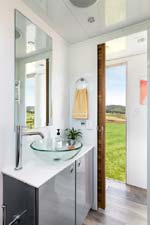 Courtesy Living Vehicle Spa-style bathroom 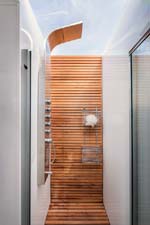 Courtesy Living Vehicle A skylight tops the shower, which is lined with naturally water-resistant and aromatic wood 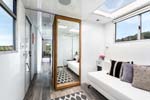 Courtesy Living Vehicle With a sofa-sleeper, the master bedroom suite can serve as an office 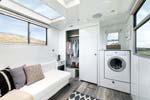 Courtesy Living Vehicle Washer and dryer combo 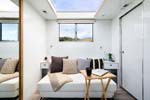 Courtesy Living Vehicle A starview skylight in the master bedroom 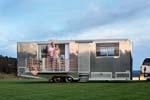 Courtesy Living Vehicle The Hofmann's on their "veranda" |
© 2018 ArchNewsNow.com